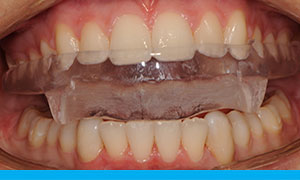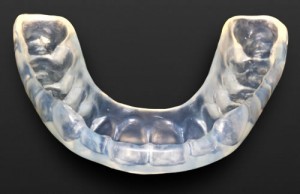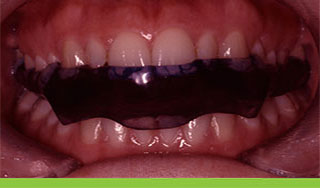Occlusal splint
A splint (also bruxism or Michigan splint ) is a fit to the arch prosthesis similar plastic overlay for the treatment of craniomandibular disorders ( disorders of the masticatory system ). The goal of therapy by means of a splint is to eliminate over-and improper loading of the teeth and jaw joints.
Application
The splint is applied to loss of substance by mechanical abrasion ( abrasion) to the teeth. You should protect the teeth from further loss of substance. The rail can be made for either the maxilla or the mandible, where rails are used predominantly in the mandible.
Poor circulation of the chewing surfaces
Often, the rail is used when the jaw is closed in a poor edition of the chewing surfaces present. This is caused by malocclusion or because the two halves of the dentition for other reasons do not fit into each other. Uneven pad creates increased abrasion of tooth substance.
Grinding and clenching
For Bruxism ( grinding / grinding and clenching of the teeth ) creates wear. Grinding and clenching is done mostly at night and mostly unconsciously. The splint acts as a protective coating for the teeth. The grinding or clenching is though this does not prevent, but because the rail is softer than the teeth, rubbed the rail at the crunch and not the teeth.
Because the rail itself is about 1 mm thick, it creates a greater distance between the lower and upper jaw. Thus, the rest position and the usual chewing patterns are changed, sometimes the unconscious grinding or clenching is interrupted.
Sequelae
Both diseases can cause a number of complications. These include: craniomandibular dysfunction, headache ( with the misdiagnosis of migraine) and also more pain; Also these are said to cause tinnitus ( causal relationship unproven ); Gnashing of teeth with associated sequelae.
Therefore, it is also important to prevent or correct the malocclusion grinding and clenching.
Effect
A bite splint causes ( if at all) only symptomatic treatment. For this, it helps by its proponents as opposed to braces, even if the position of the upper to the lower jaw does not fit. The splint is usually worn at night, in some cases, even during the day. You should reduce the unconscious grinding of teeth.
The costs are not always borne by health insurance, because investigations could the effectiveness of this measure is not yet sufficient evidence.
Production
For making an alginate impression is first made from the teeth. This is poured in die stone. On the model a hot, approximately 1 mm thick PMMA film by means of deep-drawing device is "pulled " through the model by means of vacuum. This blank is then cut out by the technician and worked ( plus eventual therapeutic grinding ). Now she has to try on the patient, where appropriate, additional pressure points and boundary edges are abraded.
For the manufacture of the rail are different hard materials are used. The production itself is subject to the same laws successful technical implementation of dental requirements: gingival contact must be avoided, sufficient for the fit encloses the rail all tooth equators or slightly above, if they are difficult to define (not available in some cases).
At the desired successful functionality of the rail, the surface ( occlusal) is of crucial importance, they are in front of the movements that can be performed even now. , Has proven the method to the already elaborated rail of thermoplastic material ( end product is a soft transparent rubber-like plastic) an individualized layer of hard plastic ( acrylate ) to apply, which can be adapted to the exact articulation of the patient.
The same method is used in the mouth guard for boxers or in conjunction with other injury- prone sports, however, be left to the individual structure, but the thickness of the film used is instead of the usual 1-4 mm desired by the athlete or necessary.
Alternatives
Often in abrasion autogenic training or other psychotherapeutic relaxation method is recommended. This is done on the assumption that unprocessed stress to strain the jaw muscles leads. Autogenic training does help to be more relaxed overall, but does not change the stress -inducing situation and the reaction with muscle tension.
Rarely Biofeedback is offered, although a) thereby selectively determine the stress -inducing situation in everyday life by measuring the voltage on the masticatory muscles could and b ) could be trained specifically by acoustic feedback, if and to relax and not to crunch.
From the holistic dentistry relationship between bruxism and pelvic obliquity were found. Accordingly, it is recommended to treat the pelvic obliquity physiotherapy. Also, links between nutrition, posture and bruxism were found.










